Smooth Green Snake
Opheodrys vernalis
Advertisement
Smooth Green Snake Scientific Classification
- Kingdom
- Animalia
- Phylum
- Chordata
- Class
- Reptilia
- Order
- Squamata
- Family
- Colubridae
- Genus
- Opheodrys
- Scientific Name
- Opheodrys vernalis
Read our Complete Guide to Classification of Animals.
Smooth Green Snake Conservation Status
Smooth Green Snake Facts
- Prey
- Insects, spiders, snails, slugs, and frogs
- Group Behavior
- Solitary/Group
- Gestation Period
- 1 month
- Habitat
- Grasslands, meadows, marshes, and open woodlands
Smooth Green Snake Physical Characteristics
- Skin Type
- Scales
- Venomous
- No
- Aggression
- Low
View all of the Smooth Green Snake images!
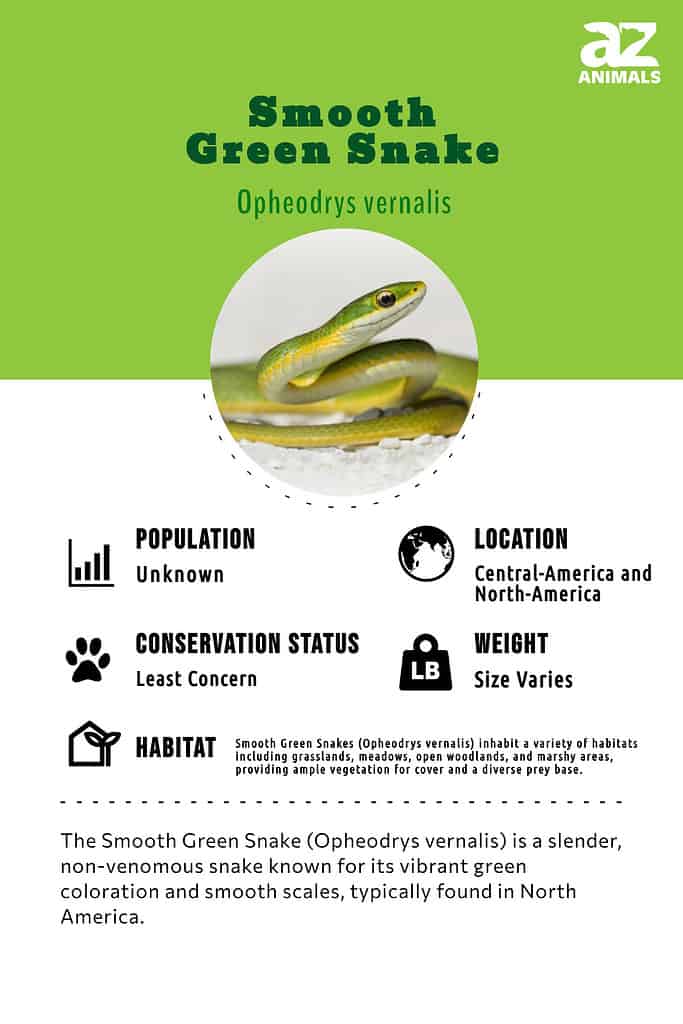
The smooth green snake is sometimes found in large groups of other snakes when it’s resting or hibernating.
The smooth green snake, also known as the grass snake, is among the most common snake species in all of temperate North America. They are not considered to be poisonous to people at all. Smooth green snakes make good pets because they don’t require too much care and the price isn’t expensive.
Because they’re difficult to feed and handle, however, they are not necessarily recommended for beginners. This article will provide a thorough description of their appearance, behavior, and care.
5 Smooth Green Snake Amazing Facts
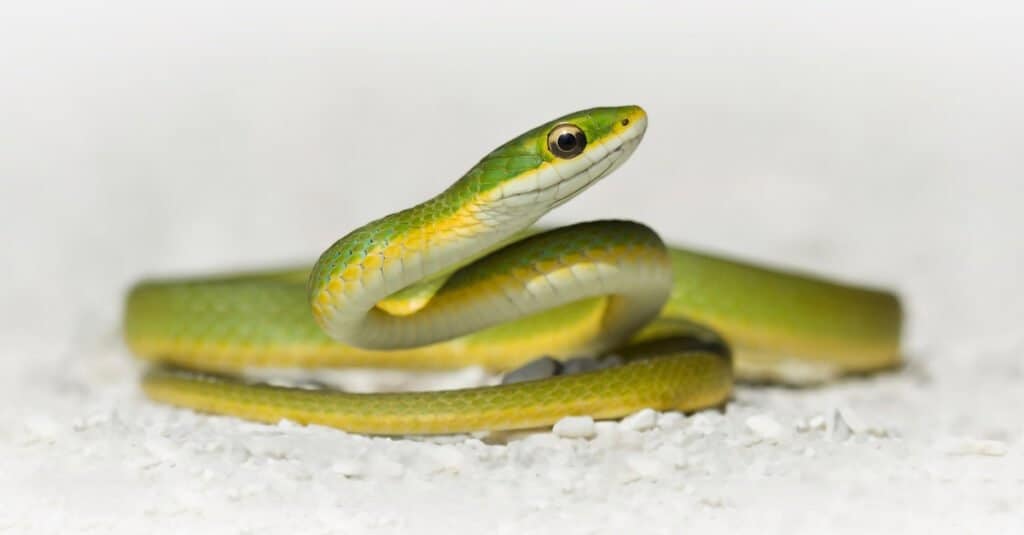
Hawks, crows, foxes, raccoons, and milk snakes are among the predators that target the smooth green snake as their prey.
©Kristian Bell/Shutterstock.com
- The reproductive season of the smooth green snake takes place in the spring or summer. After mating, the female will lay anywhere between three and 13 eggs in a small burrow, log, or rock. These nesting sites are sometimes communal in nature. The eggs will hatch around August or September after a gestation period lasting about a month.
- The smooth green snake is most active from April to October. When hibernating for the winter, it will find a burrow, anthill, or other underground areas to hide out in. The snake will often hibernate with groups of other snakes.
- The smooth green snake is preyed upon by hawks, crows, foxes, raccoons, and milk snakes.
- The smooth green snake is quite fast and agile. If threatened, they may bite, thrash around, and emit a foul-smelling liquid.
- An organ located on the roof of the mouth is used to sense odors in the air. When it flicks out its tongue, the snake is gathering odor molecules.
Evolution and Origins
The smooth green snake is an indigenous species of the Nearctic region, with its range extending from southeastern Canada to Saskatchewan in the west, and from Illinois to Virginia in the south.
The distribution of smooth green snakes encompasses northeastern Canada, stretching westward to Saskatchewan, and extending southward through Illinois and Virginia.
In addition, isolated populations can be found in various regions of the western United States, including Wyoming, New Mexico, Iowa, Missouri, Colorado, Texas, and northern Mexico.
The three types are:
- Eastern smooth green snake (Opheodrys vernalis vernalis)
- Western smooth green snake (Opheodrys vernalis blanchardi)
- Northern smooth green snake (Opheodrys vernalis borealis)
Where to Find Them
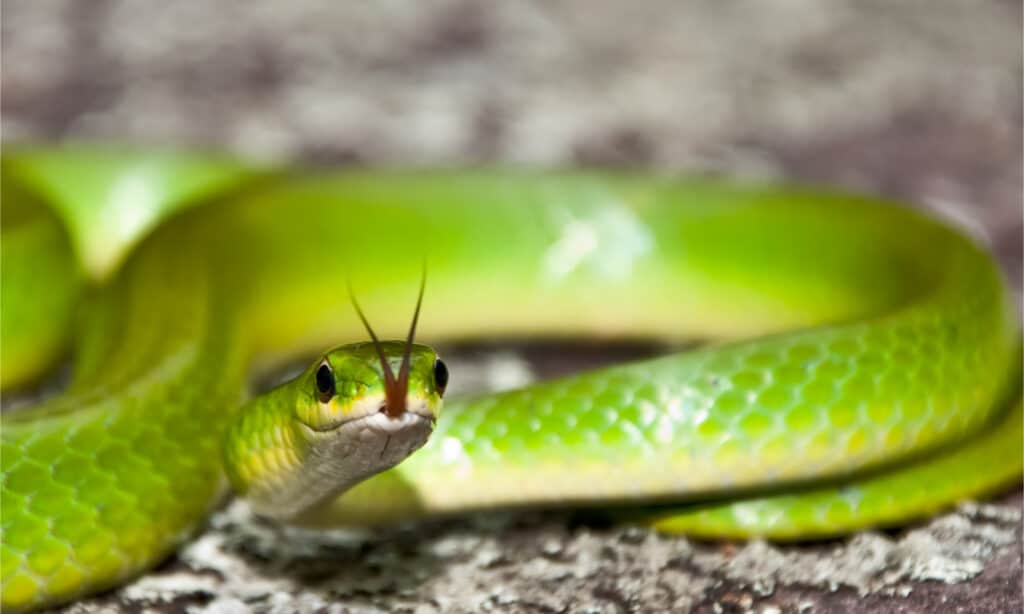
Across North America, especially in New England and the Great Lakes region, the smooth green snake can be observed in various habitats including grasslands, meadows, marshes, and open woodlands, while its range extends as far west as Wyoming.
©Jay Ondreicka/Shutterstock.com
The smooth green snake can be found in grasslands, meadows, marshes, and open woodlands across North America, particularly in New England and the Great Lakes region; the greatest western extent of their range stretches out to Wyoming.
It prefers to stay in areas with plenty of grass and vegetation where its camouflage provides a very useful defense against predators. It comes out during the day to bask near rocks or logs, which double as a hiding spot. It also has the ability to climb in trees and bushes to evade predators. The three countries in which it’s found include:
Scientific Name
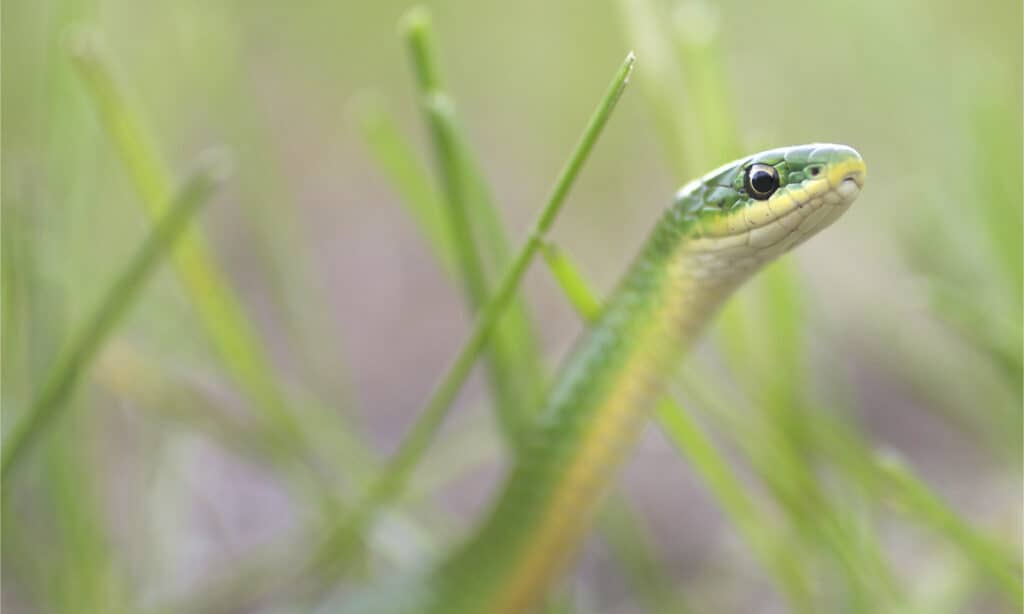
Opheodrys vernalis is the scientific name for the smooth green snake, where “Opheodrys” can be traced back to Greek roots, combining “opheios” meaning snake, and “drys” meaning tree.
©David Schliepp/Shutterstock.com
The scientific name of the smooth green snake is Opheodrys vernalis. Opheodrys essentially translates from Greek to mean tree (drys) and snake (ophios). Vernalis comes from the old Latin meaning of or related to springtime. Three subspecies of the smooth green snake are recognized, including the eastern, the western, and the northern smooth green snake. The only other species within the same genus as the rough green snake.
Population and Conservation Status
The smooth green snake is considered to be a species of least concern by the IUCN Red List. Population numbers have never been properly estimated, but it appears that habitat loss and pesticide use have contributed to the decline of their population in some parts of their range.
Appearance and Description
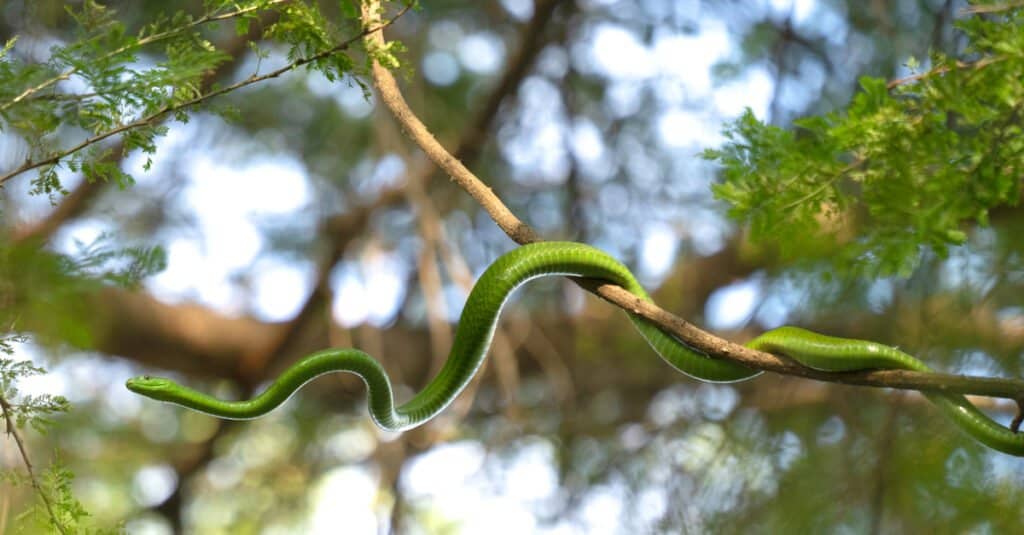
The green mamba is a long, slender-bodied snake with smooth scales and a narrow, coffin-shaped head.
©Dominyk Lever/Shutterstock.com
The smooth green snake or grass snake is a very short and slender species, measuring no more than 26 inches long. It is characterized by a bright emerald green back and yellow or white underside. And unlike the closely related rough green snake, this species has smooth scales along the surface of the back.
There is some minimal variation in the color between different regions; some have olive or light brown skin color. Some are also said to have blue speckles. Females are generally larger than males, but they have shorter tails.
The following description should help you identify the smooth green snake:
- Slender body measuring no more than 26 inches long
- Smooth scales
- Bright green back and yellow or white belly
- Its head is about the same shape as the body
- Large round eyes in relation to body size

Smooth green snakes have smooth scales along their backs.
©iStock.com/tamers1
How Dangerous Are They?
The smooth green snake is considered to be completely harmless to humans because it is not poisonous at all. If threatened or stressed, the smooth green snake may attempt to bite, but it will probably not do any real damage to human skin.
Behavior and Humans
The smooth green snake or grass snake is fairly timid and shy around people. They have a natural instinct to run away and hide. If you plan to keep one as a pet, then you should be aware that they can become stressed easily and do not always like to be handled. On the plus side, this snake is completely harmless, and it’s considered to be relatively easy to care for (except perhaps for its feeding behavior).
View all 293 animals that start with SSmooth Green Snake FAQs (Frequently Asked Questions)
Are smooth green snakes venomous?
The smooth green snake is not poisonous or venomous in any way.
How do smooth green snakes hunt?
Smooth green snakes locate prey through their vision and excellent sense of smell. They also have the ability to detect vibrations through the ground. These snakes will strike quickly and swallow its prey whole without biting.
Are smooth green snakes aggressive?
They are not considered to be aggressive toward people at all.
Where do smooth green snakes live?
They live in grasslands, meadows, marshes, and open woodlands throughout temperate North America. They are most commonly found in the northeastern part of the United States, but some scattered populations are found out in the western US.
What do smooth green snakes eat?
Their diet mostly consists of insects such as crickets, grasshoppers, beetles, and centipedes. They also consume spiders, snails, slugs, and frogs. In captivity, it is a good idea to feed your pet snake a combination of store-bought insects, worms, and other soft-bodied food about once or twice a week for a 20-minute period. Dawn or dusk is usually the most natural period. However, the smooth green snake can be a little difficult to feed in captivity, because they sometimes show no interest in food. It is a good idea to feed your snake in a quiet room with minimal stress and noises.
Are smooth green snakes friendly?
They are considered to be fairly tame around people, but they can also become stressed easily and don’t necessarily like being handled.
What is the difference between a rough green snake and a smooth green snake?
The main determining characteristic of the smooth green snake is the presence of smooth dorsal scales on the back. The rough green snake, by contrast, has rough keeled dorsal scales on the back. For a complete description, see the appearance section.
Can you have a smooth green snake as a pet?
Yes, the smooth green snake does make a good pet. They can be purchased for a relatively cheap price and don’t require too much care or upkeep, but keep in mind they don’t like to be handled very often. These snakes require at least a 30-gallon tank with live plants, a clamp-down lid, and plenty of vertical space for climbing. They also need a heat bulb or ceramic heater with a suggested temperature gradient of 70 to 80 degrees Fahrenheit, and the humidity should be set at around 40 to 50 percent at all times. A reptile carpet or newspaper usually works best as a suitable substrate, because they won’t ingest the material. A UV light used 12 hours a day is also recommended. The annual price of food and equipment could add up to a few hundred dollars per year.
Thank you for reading! Have some feedback for us? Contact the AZ Animals editorial team.
Sources
- Animal Diversity, Available here: https://animaldiversity.org/accounts/Opheodrys_vernalis/
- Virginia Herpetological Society, Available here: https://www.virginiaherpetologicalsociety.com/reptiles/snakes/smooth-green-snake/smooth_greensnake.php

















